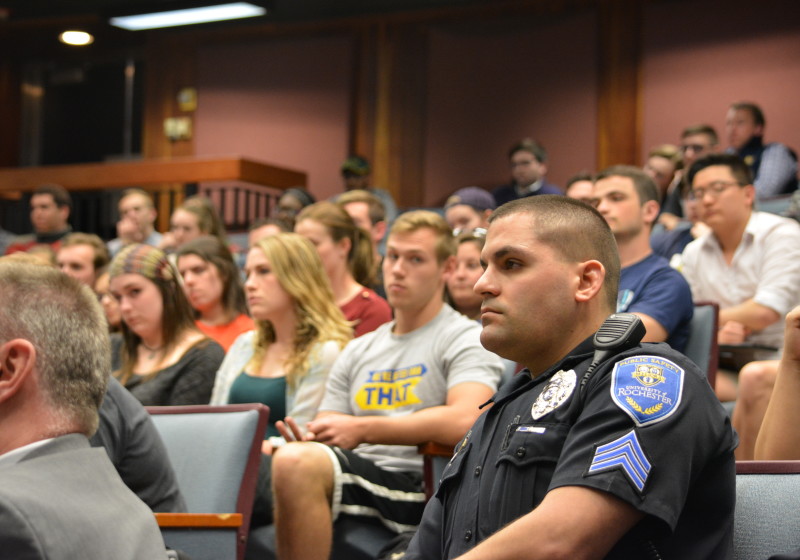Forty-two Public Safety officers will be armed with guns sometime in the near future—38 at the Medical Center and four senior officers on campus, or almost a quarter of the force—University President Joel Seligman announced on Oct. 13.
And there are plans to consider equipping them with body cameras, too.
Seligman accepted in full the UR Security Commission’s recommendation to arm officers two Thursdays ago, announcing his decision in an email to the University community that morning.
There will be between 10 and 12 armed officers at the Medical Center at any given time, and a review board will be put together to annually evaluate Public Safety and any incidents it may have involving use of force.
Seligman held a small press conference the day of his announcement to discuss his decision in more detail, at which he said the review board is planning to consider the merits of giving officers body cameras and cited the December 2015 kidnapping of two UR seniors as an impetus for arming officers.
“The kidnapping of two of our students last December was a very important wake-up call that we had to take appropriate steps, measured steps, so that if we were ever faced with a situation like that we could respond, and we could respond effectively,” he said of the incident, which happened off campus.
Seligman’s decision is the end of an issue that has wracked campus since last semester, evoked overwhelming opposition among pockets of students and faculty, and brought to the foreground the question of weighing the safety of racial minorities on campus against the safety of Medical Center employees.
“The decision to arm 38 officers in the Medical Center is directly responsive to the concerns of many in the Emergency and sometimes other departments based upon a pattern of actual behavior,” Seligman wrote in his full memo on the University’s website. “The combination of the deterrent of some officers in the Emergency Department being armed potentially combined with metal detectors will enable all who work or proceed through the Emergency Department and elsewhere in the Medical Center to receive the type of protection that has become standard in most of our peer institutions today.”
A breakdown of the emails Seligman received regarding the recommendation showed that 58 percent of writers supported adopting the recommendation, a majority of which came from Medical Center employees. Among non–Medical Center writers, 57 percent favored the recommendation, as well.
The review board, chaired by University Trustee Francis L. Price ’74, ’75S, will “ensure to our University community that weapons are not abused by our Department of Public Safety,” Seligman said in his announcement. It will annually include one undergraduate appointed by the Students’ Association Government
Seligman’s decision came despite vocal opposition to arming Public Safety officers from students and faculty—particularly those of color—and after some took issue with the Commission’s data, which lumped together campus officer shootings numbers with suicides and accidents.
“Sadly, I have the feeling in the pit of my stomach that this issue was cemented from the beginning of any particular dialogue,” said Daniel Southwell, a junior who spoke passionately against the recommendation at Seligman’s Sept. 12 Interfaith Chapel forum.
Southwell, who is black, called the Commission’s evidence unsatisfactory, and said that “there is no data on the direct and positive correlation between the presence of firearms with social cohesion, interracial relations, managing mental health or anything besides injury and death.”
“I could be wrong, but I doubt this will improve the delivery of medical care, and I know it will increase the angst of the real, poverty stricken Rochester community members,” he said.
No timeline for arming officers was included in Seligman’s announcement, and at his press conference that day, he said firearms training would not begin until an initial report by the review board is compiled.
“I share with my students of color the last thing I want is anyone to feel the potential of being profiled or abused because of the color of one’s skin,” he said at the conference, held in Wallis Hall and attended by local media and administrators.
“The issue is not to use the guns—that’s the last thing we want to do,” he said. “It’s to prevent others from using weapons.”
Director of Public Safety Mark Fischer pointed in a separate interview to the department’s record as evidence that excessive use of force would not be a problem for the newly-armed officers.
“I think you’ve got to take a look at our track record as a department,” he said. “You know, this is not a department that engages in bias-related incidents […] You’re not talking about arming a troubled department, or a department that uses excessive force, or has a lot of force complaints or bias complaints.”
DPS has received five racial bias complaints since 2014, four of which were deemed unfounded.
“I don’t anticipate that I’m going to convince people who are just adamantly opposed,” Fischer added, “but I think I’m going to prove it to the community, and that these officers are going to prove to this community, that they’re going to handle this responsibly, as they did the peace officer authority.”
Fischer noted that there was strong opposition to the department’s incorporation of peace officers onto its force, saying that “there were a lot of the same arguments” presented then as the ones raised before the recent decision.
In response to concerns about DPS officers’ newly-armed status affecting the community surrounding UR, Fischer said that the department’s intent is not to go into surrounding neighborhoods, and that any extra-campus jurisdiction it has effectively applies to “sidewalks and roadways.”
The main concern of the department, he emphasized, is the welfare of students and UR-affiliated individuals.
Besides, he added, the Rochester Police Department “doesn’t want us policing their territory.”
DPS officers’ jurisdictional boundary extends 100 yards beyond University property, which Deputy Director of Public Safety Gerald Pickering said mirrors existing jurisdictional boundaries under New York State law. Pickering is the former Webster town police chief.
Updated: 10/24/16







